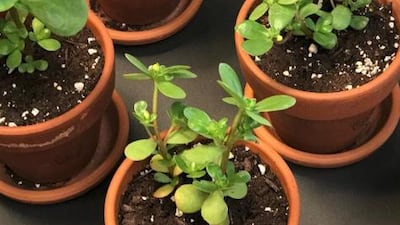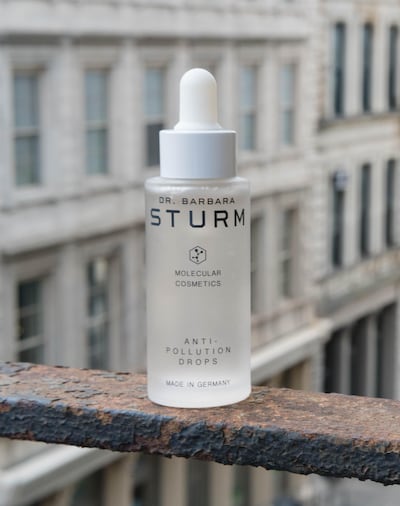A tropical greenhouse in Malaysia’s Universiti Putra was the stage for a five-month-long experiment on the benefits of purslane in 2012. The most definitive study of its kind, it attributed to this humble herb superlative phrases that are manna to the ears of skincare creators and consumers alike: high antioxidant properties; richest vegetable source of omega-3; and high levels of vitamins E, C and beta-carotene.
To put these into perspective, consider: vitamins E and C are strong captors of the free radicals that wreak havoc on our skin; combining them is symbiotic, since they are able to regenerate each other. That they occur together naturally in purslane makes this a powerful anti-ageing catalyst. Add to that the plant's beta-carotene component – the stuff that glowing, UV-protected skin is made of.
Throw omega-3 fatty acids into this heady mix, and you introduce the anti-inflammatory properties that are a crucial part of skin’s natural lipids, which bolster the barrier function. However, we lose these good, skin-plumping fats as our cells mature, and so a product with omega-3 acts like a seal – locking moisture in and irritants out.
One skincare pioneer who put purslane in a Petri dish early on is Dr Barbara Sturm, founder of German brand Molecular Cosmetics, and creator of the vampire facial and blood cream. It was this latter product, which introduces your own plasma into a truly bespoke Dh5,000 moisturiser, that first benefited from the ingredient.
“I came across purslane when I was formulating my MC1 blood plasma cream, and working with scientists from the universities of Pittsburgh, Miami and Harvard, who had been studying the beneficial effects of topical and oral purslane,” says Sturm, who holds a doctorate in sport and orthopaedics. “Purslane is packed with nutrients and anti-ageing compounds, which have dramatic anti-inflammatory, anti-oxidative, astringent and wound-healing properties, which accelerate the healing of damaged skin.”
So impressed was Sturm by what she observed that purslane is now to be found “in high doses” in every single product she has created, from the cleanser, face mask and eye cream to the anti-pollution drops, anti-ageing primer and Darker Skin Tones, the new collection that Molecular Cosmetics launched in Dubai in March.
The dramatic results Sturm speaks of are linked directly to the 23 pairs of chromosomes that carry human DNA. At the end of each chromosome is a protective cap called a telomere. Each time a cell divides, the telomeres are snipped shorter, until eventually they stop working. “The shortening of our telomeres leads to cellular dysfunction and, ultimately, cell death. This is the cause behind much of the wear and tear associated with ageing and skin damage,” explains Sturm.
Enter purslane. Clinical trials have proved that the plant mediates and up-regulates the telomerase enzyme, which in turn prevents the telomere cap from shortening. Commonly known as the youth enzyme, telomerase was the subject of the study that won the 2009 Nobel Prize in Medicine.
"Because of the antioxidant, hydrating and photo-protective properties exhibited by purslane, using it in beauty products should improve blood flow and hydration, brighten the skin and stimulate cell repair," confirms Dr Sonia Wilson, a specialist dermatologist at RAK Hospital. "This, in turn, decreases the appearance of wrinkles, redness and scars. Some studies have shown that consuming purslane [diminishes] oral lichen planus, a chronic inflammatory skin condition. And products containing purslane are even suitable for reactive and sensitive skin," Wilson explains.
Despite this uncontested evidence, though, Sturm's is just one of a handful of skincare companies that uses purslane, and the only one to do so across its product range. "Purslane has been a part of traditional Chinese medicine for a number of curative reasons," explains John Eakins, managing director of Nord Mason Asia, the parent company of Huxley. The skincare brand from Singapore lists prickly pear cactus seed oil as its hero ingredient, and combines this with purslane in its top-selling Secret of Sahara Anti-Gravity cream. "Purslane is a perfect complement for Huxley because it is rich in omega-3 fatty acids, which when combined with our oil, forms a protective barrier and helps skin to better absorb the antioxidants and vitamins from other ingredients."

Likewise, South Korea's BioAqua and Missha skincare companies list Portulaca oleracea among the ingredients of popular but one-off products. The former uses it in the Wild Vegetables Hydra Treatment Mask and the latter combines it with cell renewing snail slime in its Super Aqua Cell Renew cream, while California company Ceramiracle has a single K-beauty-style Reboot mask infused with it to purify and condition the skin.
You'd be forgiven for believing that purslane is a sparse herb that needs to be grown in hyper-idyllic conditions on the foothills of some fabled mountain. The truth is it can and does grow everywhere and was, inaccurately, considered an annoying garden weed until a few years ago. In fact, purslane is an integral part of Middle East cuisine; you might know it better as farfahin, the crunchy green leaves that are found on every plate of fattoush and in many a fatayer.
It’s fortunate, then, that skincare potions are not the only way to get your purslane fix. In addition to what we put on our body, what we put in it also has an impact on the external appearance and internal well-being of our skin.
“Purslane is now considered to be a superfood, owing to its antibacterial characteristics and detoxifying action. It is also low in calories, with about 16 per 100 grams,” notes Dubai dietician Ruba ElHourani. “It also packs the highest amount of vitamin A present in any leafy vegetable, which is excellent to maintain healthy vision and cell integrity, while omega-3 fatty acids lower the risk of heart disease.”

ElHourani recommends adding freshly washed purslane to a sandwich in lieu of lettuce or a multi-leaved salad, complementing it with a dash of lemon-thyme dressing. Turkish beach bistro Kaftan at La Mer, meanwhile, serves purslane smothered in its yoghurt Semizotu, while most Lebanese restaurants put purslane in their fattoush and baldieh salads.
The famed Afrikaans poet and doctor C Louis Leipoldt noted at the turn of the 20th century: “Purslane was, in the old days, and should be today, a favourite vegetable. Its little succulent leaves were gathered, washed and braised with ginger powder, mace, pepper and salt in fat; a tiny spicule of garlic was added, a wineglassful was stirred in, and the result was an amazingly delicate, luscious and sapid purée.”
Tellingly, Sturm has also infused her dietary supplements with the stuff, a genre she claims has a salient role to play in the fast-paced, poor-diet lives we lead today. Skin Food and Repair Food combine a powdered form of the “fountain of youth” purslane compound with ellagic acid (found in most fruit and veg) and boswellia, a herbal extract from the tree that also yields frankincense.
“Purslane is effective not only topically, but also systemically, which is why I deploy it in my oral supplements. My family eats purslane salads and drinks purslane smoothies; it is tremendously nutritious and anti-inflammatory,” says Sturm. “Beauty and wellness both begin from within.”



